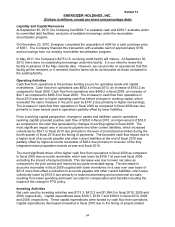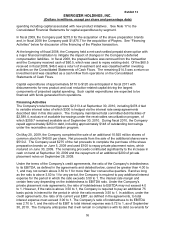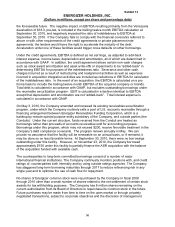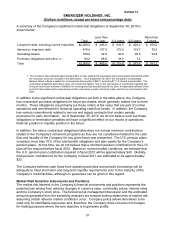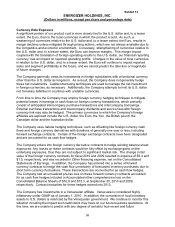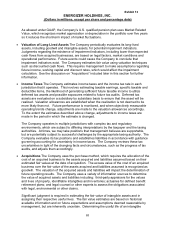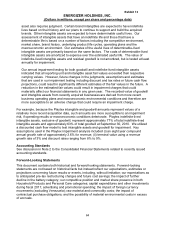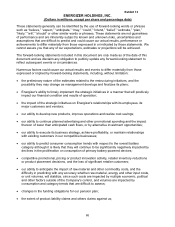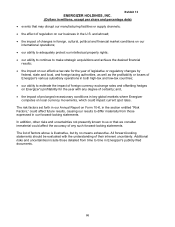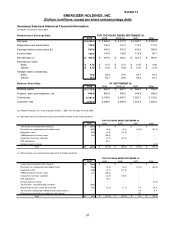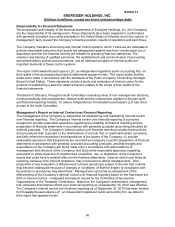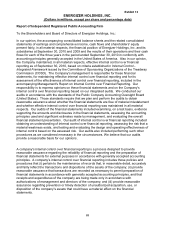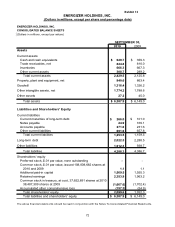Energizer 2010 Annual Report Download - page 73
Download and view the complete annual report
Please find page 73 of the 2010 Energizer annual report below. You can navigate through the pages in the report by either clicking on the pages listed below, or by using the keyword search tool below to find specific information within the annual report.
Exhibit 13
ENERGIZER HOLDINGS, INC.
(Dollars in millions, except per share and percentage data)
63
As allowed under GAAP, the Company’s U.S. qualified pension plan uses Market Related
Value, which recognizes market appreciation or depreciation in the portfolio over five years
so it reduces the short-term impact of market fluctuations.
• Valuation of Long-Lived Assets The Company periodically evaluates its long-lived
assets, including goodwill and intangible assets, for potential impairment indicators.
Judgments regarding the existence of impairment indicators, including lower than expected
cash flows from acquired businesses, are based on legal factors, market conditions and
operational performance. Future events could cause the Company to conclude that
impairment indicators exist. The Company estimates fair value using valuation techniques
such as discounted cash flows. This requires management to make assumptions regarding
future income, working capital and discount rates, which would affect the impairment
calculation. See the discussion on “Acquisitions” included later in this section for further
information.
• Income Taxes The Company estimates income taxes and the income tax rate in each
jurisdiction that it operates. This involves estimating taxable earnings, specific taxable and
deductible items, the likelihood of generating sufficient future taxable income to utilize
deferred tax assets and possible exposures related to future tax audits. Deferred tax
assets are evaluated on a subsidiary by subsidiary basis to ensure that the asset will be
realized. Valuation allowances are established when the realization is not deemed to be
more likely than not. Future performance is monitored, and when objectively measurable
operating trends change, adjustments are made to the valuation allowances accordingly.
To the extent the estimates described above change, adjustments to income taxes are
made in the period in which the estimate is changed.
The Company operates in multiple jurisdictions with complex tax and regulatory
environments, which are subject to differing interpretations by the taxpayer and the taxing
authorities. At times, we may take positions that management believes are supportable,
but are potentially subject to successful challenges by the appropriate taxing authority. The
Company evaluates its tax positions and establishes liabilities in accordance with guidance
governing accounting for uncertainty in income taxes. The Company reviews these tax
uncertainties in light of the changing facts and circumstances, such as the progress of tax
audits, and adjusts them accordingly.
• Acquisitions The Company uses the purchase method, which requires the allocation of the
cost of an acquired business to the assets acquired and liabilities assumed based on their
estimated fair values at the date of acquisition. The excess value of the cost of an acquired
business over the fair value of the assets acquired and liabilities assumed is recognized as
goodwill. The valuation of the acquired assets and liabilities will impact the determination of
future operating results. The Company uses a variety of information sources to determine
the value of acquired assets and liabilities including: third-party appraisers for the values
and lives of property, identifiable intangibles and inventories; actuaries for defined benefit
retirement plans; and legal counsel or other experts to assess the obligations associated
with legal, environmental or other claims.
Significant judgment is required in estimating the fair value of intangible assets and in
assigning their respective useful lives. The fair value estimates are based on historical
available information and on future expectations and assumptions deemed reasonable by
management, but are inherently uncertain. Determining the useful life of an intangible



